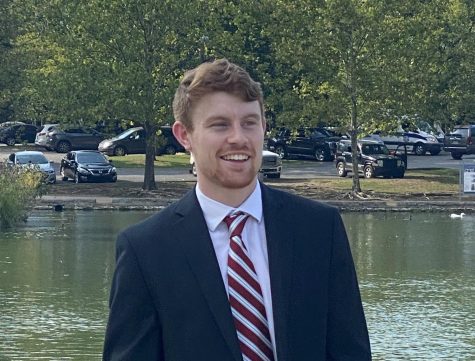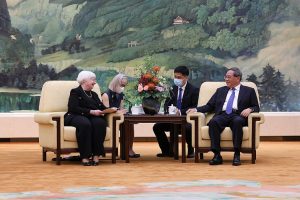OP-ED: The Supreme Court Should Use an Upcoming Decision to Preserve Our Fourth Amendment Rights
April 24, 2021
In the next few months, observers expect a decision from the Supreme Court on Lange v. California. The ruling will decide whether the Fourth Amendment protects someone who has committed a misdemeanor in public and fled from police officers. If the Supreme Court is to uphold the core principle of the Fourth Amendment, it must rule in favor of solidifying this protection.
The case began with an incident on Oct. 7, 2016 involving a man by the name of Arthur Gregory Lange. A California highway patrol officer observed Lange playing music loudly from his vehicle and repeatedly honking his horn despite there being no other vehicles nearby. The officer followed Lange, intending to conduct a traffic stop. Once the officer had approached within 500 feet of Lange, he turned on his overhead lights, signaling for Lange to pull over.
However, Lange was already nearing his residence. Rather than pulling over, Lange drove into his driveway and entered his garage. The officer followed Lange on foot, stopped the garage door before it closed, and entered Lange’s home. When the officer asked whether Lange had noticed his lights, Lange claimed to not have been aware. The officer administered field sobriety tests to Lange, and he then took him to the hospital where his blood-alcohol content was determined to be 0.245%, which is three times the legal limit. Lange was arrested and charged with two misdemeanors of driving under the influence (DUI) of alcohol and playing his vehicle’s sound system at excessive levels.
Lange filed a motion to suppress the evidence gathered in his garage on the grounds that the officer’s entrance into his home violated the Fourth Amendment, which prohibits entry into a citizen’s home without a warrant. After Lange’s motion was denied by both the trial court and the appellate division of the Sonoma County Superior Court, he petitioned to transfer his case to the California Court of Appeals for the First Appellate District, which was granted.
The Court of Appeals reaffirmed Lange’s conviction, reasoning that the officer’s warrantless entry into Lange’s home was justified because he was in hot pursuit of Lange. This “hot pursuit” exception is a legal doctrine which says that if a police officer is in pursuit of someone who has committed a felony in a public space, they may follow this person into a private residence without an arrest warrant.
However, courts have been divided over whether the hot pursuit doctrine applies in cases like Lange’s, where a misdemeanor is committed. According to Lange’s brief, five state supreme courts have ruled that misdemeanor pursuit always justifies warrantless entry into a home, while two federal courts of appeals and three state supreme courts held that justification for warrantless entry on the basis of misdemeanor pursuit requires a case-by-case examination.
The Supreme Court granted a writ of certiorari regarding Lange’s case on Oct. 19, 2019, and the Court held oral arguments on Feb. 24, 2021. During the arguments, Justice Neil Gorsuch weighed in, stating that the police do not “have the power to enter the home in pursuit of any and all misdemeanor crimes.”
Gorsuch’s sentiment is exactly right. Lange was only observed committing, at worst, minor traffic violations. Allowing all misdemeanors to be subject to the hot pursuit doctrine will give police officers the power to enter homes without a warrant for a wide variety of small and harmless offenses. It will become nearly effortless for police to make arrests based on the observation of even the smallest infractions, which is antithetical to everything the Fourth Amendment stands for.
When considering these issues surrounding the Fourth Amendment, one cannot help but think of the tragic death of Breonna Taylor in March of 2020. While police did have a warrant to enter Taylor’s home, needless deaths during home searches would only increase with the expansion of the hot pursuit clause. Citizens should not have to fear death for minor offenses. The Fourth Amendment works to eliminate this fear, but an unfavorable decision inLange v. California could potentially undermine the Fourth Amendment’s purpose.
Gorsuch also pointed out during the oral arguments that the constitutional questions within Lange’s case are still relevant to felonies. “We live in a world in which everything has been criminalized. And some professors have opined that there’s not an American alive who hasn’t committed a felony [under] some state law,” he told the state’s lawyer.
Instead of basing exceptions to the Fourth Amendment on felony categorization, Gorsuch suggested that we should “retreat back to the original meaning of the Fourth Amendment, [which says] that [an officer can] go into a home without a warrant if the officer sees a violent action or something [that poses] imminent violence.”
Again, Gorsuch makes a point consistent with the foundation of the Fourth Amendment. The Fourth Amendment was based on common law understanding, where felonies consisted of very few crimes, mostly punishable by death. With such a wide array of acts being considered felonies today, it is unconstitutional to apply the hot pursuit doctrine to every felony committed.
Ultimately, if the Fourth Amendment’s purpose is to be truly preserved, the Supreme Court must not only rule in favor of Lange, but also hold that the hot pursuit doctrine should only apply in the event of a violent crime where a warrantless entry will likely prevent imminent threats to others. The Supreme Court has partaken in the degradation of our Fourth Amendment rights many times throughout United States history. This is a chance for the Court to fulfill their enumerated duty and protect our Fourth Amendment rights at a time when abuse of police power is rampant across our nation.
Image Credit: “United States Supreme Court Building in Washington D.C.” (unmodified) by Marielam1 is licensed under CC BY-SA 4.0.








